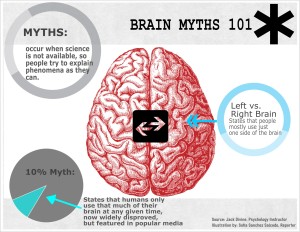Sofia Sanchez Salcedo
Reporter
Much information humans learn through popular culture and even previous education, is negated and corrected when we attend college, or otherwise become more educated. So why are these myths so persistent? In short, they are stereotypes that were relevant at one point, but have since fallen out of favor when new technologies arise that allow hypotheses to be disproven or proven true.
One of the more interesting myths is that of the right and left brain.
“From a scientific research standpoint, there is no evidence,” said Jack Divine, social science instructor.
Divine said it was a ‘benign lie,’ which allows people to maximize their potential; furthermore, he said it is similar to the proverb you can accomplish anything with hard work. Not everyone can be an Olympic sprinter, but everyone healthy and able can start running.
It was “Probably started by people who aren’t educated, and don’t fact check,” said McKaela Warren, psychology major, “In fact, in my biology class we were told we couldn’t use ten percent of our brain.”
“I think the left vs. right brain myth is less untrue than the ten-percent brain myth,” said Divine.
To further complicate things, movies like “Matilda” (1996), or “Lucy” (2014) are visible movies that showcased the myths. If biology instructors don’t help explain to students that not being able to use one hundred percent of the brain isn’t the same as having supernatural powers with using all the brain at the same time, how are students to learn these things are false?
Myths are popular because they explain phenomena that could otherwise not be explained; however, as technology evolves to shed light on these issues, we must mold our knowledge accordingly. Students, if no one else will, should think before baseless myths get circulated.
Divine also said that from a neurology standpoint, the more sophisticated technology gets, the more knowledge is available to the public, and the more myths are confirmed or dismissed.


Leave a Reply